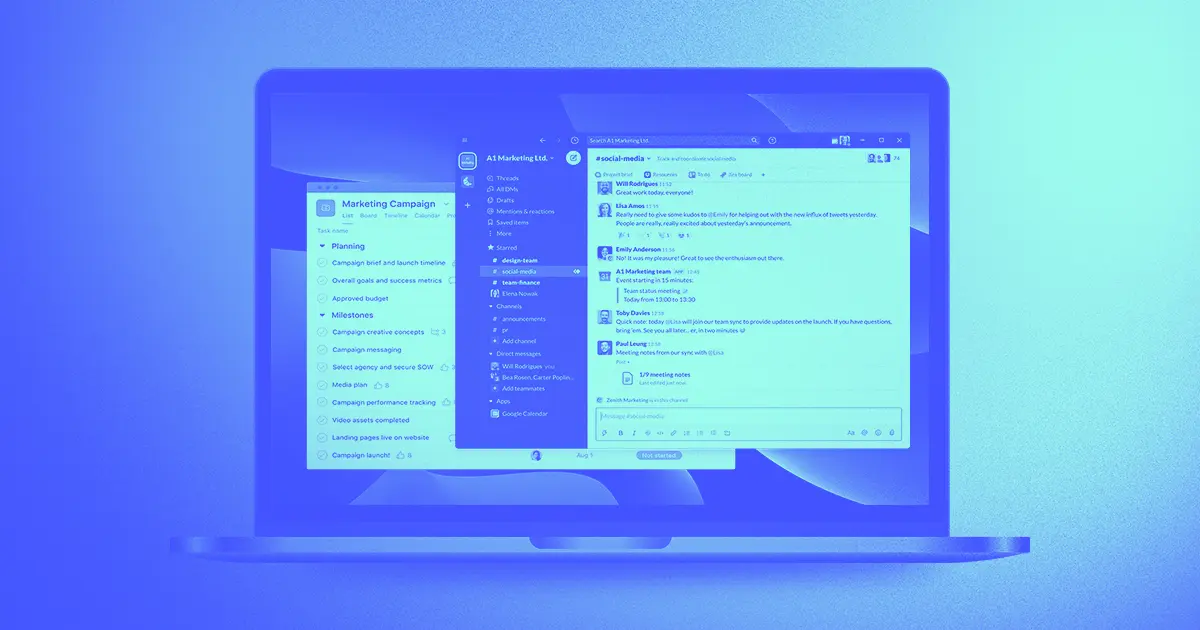Collaboration is key, and so are the tools that make it happen.
With the recent increase in hybrid and remote work, team collaboration tools have become more critical than ever. They bridge the distance so teams can generate ideas, distribute tasks, and share results effectively — regardless of physical location.
This surge in demand has made collaboration tools a hot commodity. New apps are released constantly, each promising more features and reliability than the last.
With so many products vying for attention, choosing the right suite of tools for your team can be challenging. Read on to determine which of the 10 best collaboration tools on the market meet your needs.
Why use tools for collaboration?
Maybe you’ve used Microsoft Teams or Slack for instant messaging, and Outlook or Gmail for email. And you may be familiar with Trello, Asana, or ClickUp for task management. These tools are common in many industries, and they’re especially useful for addressing increased cross-country and global collaboration.
In addition to keeping pace with changing workplaces, here are the main benefits of integrating collaboration platforms into your company’s workflow.
Increased productivity
Collaboration tools simplify basic tasks, like scheduling meetings, sharing files, and tracking projects. They reduce the time it takes to collaborate on projects and improve team collaboration overall.
For example, consider the ways to edit a document. You could download the file, make your proposed edits with strikethroughs and different font colors, and send it back to the writer. Alternatively, you could use Google Docs to seamlessly make comments and exchange ideas with the writer and other stakeholders in real time — a simpler and faster process that empowers you to make even the most subtle changes.
Reduced costs
Think of all the materials you use during a given workweek, like meeting agendas, design mock-ups, and reports. If you’re meeting in person, you might print numerous copies to hand out at meetings or send to stakeholders.
Collaboration tools make it possible to share documents and designs digitally and host stakeholder meetings virtually. Cloud space is much cheaper than office space, and it also generates less physical waste.
Improved project management
The best collaboration tools on the market provide intuitive ways to visualize, streamline, and manage projects. Asana, Trello, and ClickUp are popular examples — and for good reason. These versatile tools all offer customizable project views that can tell you precisely how things are progressing, at a glance.
Types of collaboration tools
You likely won’t need every type of tool you encounter, but it helps to understand the basic kinds so you can decide which bases to cover. Here are a few key categories of collaboration tools:
- File-sharing apps for storing, distributing, and managing access to files stored in the cloud
- Communication apps for sending and receiving emails or instant messages
- Project management tools that use strong visuals to help track and manage tasks
- Design software that enables users to collaborate on documents and designs, often in real time
- Scheduling tools for managing calendars that are shared across teams, to coordinate meeting times, important dates, and deadlines
What to look for in a collaboration tool
With so many options, selecting the correct tool for your company can feel challenging. You want to choose something with up-to-date features, but you also want something with a proven track record. Switching to a different collaboration platform in the future would be a hassle, with wasted time and effort, so making the right choice from the outset is important.
Here are a few characteristics to look for when selecting collaboration tools for the long term.
Ease of use
Look for tools that are simple to learn relative to their complexity. Jira, for example, is a complex tool with many excellent features, but its cluttered design can make it challenging to learn. ClickUp, Asana, and Trello have similar features, but their intuitive, colorful user interfaces make them more accessible to new users. They also offer helpful templates you can use to create tasks instantly.
Compatibility
The most useful collaboration tools integrate with other platforms and ecosystems. Avoid tools that export files in proprietary formats.
Microsoft, for example, makes a solid instant messaging app (Teams) that supports many integrations, but their Office 365 software locks you into a select group of file formats. Google has the opposite problem: Google Drive allows you to create and export documents in a wide range of formats but their instant messaging app, Google Chat, lacks the integration compatibility of its competitors. That’s why some teams rely on Google Drive for file sharing but use Microsoft Teams for communication.
Versatility
Prioritize tools that cover more than one function. You don’t need a one-stop shop for everything, but curating a tight tool suite that relies on as few unique products as possible can streamline workflows.
Trello is an excellent example of versatility in action. Its primary function is creating Kanban boards, a visual system for organizing and streamlining tasks. And you can also use it to automate project management, schedule meetings, and gather productivity metrics.

Scaling team collaboration
Learn practical insights on effectively scaling processes and enhancing workflows in this free webinar.
The 10 best collaboration tools
The following 10 tools are the top performers in each category. They each have a strong mix of favorable characteristics: ease of use, compatibility, and versatility. Plus, they come from trustworthy brands with long histories of success.
1. Google Drive
Category: File sharing, design
Google Drive earns high marks for compatibility, versatility, and ease of use. Users can collaborate on documents in real time, export files in various formats, and manage file access in a snap.
2. Figma
Category: Design
Figma is a specialized tool made specifically for designing interfaces. It allows for real-time collaboration. Its various design tools make creating and updating designs intuitive to learn.
3. Zoho
Category: File sharing, design, communication, scheduling
Zoho is a collaboration platform centered around sales and marketing. In addition to its well-respected CMS, it offers email services, appointment scheduling, and document collaboration tools. However, it includes insubstantial project management functions, which is a drawback. If you already have a trusted project management tool, Zoho can help with everything else.
4. Slack
Category: Communication
Slack specializes in instant messaging. They’ve recently also been testing the waters of conferencing and file sharing with new features like canvases, huddles, and workflows. Plus, many other tools support Slack integrations for seamless information sharing.
5. Zoom
Category: Communication
Zoom video calls are consistently stable and easy to join. Zoom also offers instant messaging and a helpful digital whiteboard feature. The app integrates with popular calendar tools to facilitate seamless scheduling. The Scheduler feature enables users to share their availability across platforms.
6. Microsoft Teams
Category: Communication, scheduling
Microsoft Teams is a reliable, secure communication platform. The best features include the calendar, video conferencing, and instant messaging. But file sharing and document collaboration through Teams is a clunkier experience compared to Google Drive.
7. Google Calendar
Category: Scheduling
Google Calendar is a trusted tool for scheduling and sharing availability. It automatically syncs with Gmail and supports integration with other communication platforms, like Zoom, Zoho, and Slack. And its UI is clean and straightforward, which makes incorporating it into your workflows simple.
8. Miro
Category: Project management
Miro is a versatile whiteboard tool that allows users to create curated boards to track tasks, analytics, and workflows. It supports integrations with over 100 other tools, earning it high marks for compatibility.
9. Trello
Category: Project management
Trello is a widely-respected industry leader in project management software — over two million teams use this product worldwide. The free version offers a robust feature set with no user cap, making it popular with teams who are scaling up. It’s most helpful in creating visually appealing and easy-to-understand Kanban boards.
10. ClickUp
Category: Project management
ClickUp is a relative newcomer to the project management industry with a lofty mission of becoming one app to replace all others. The platform offers document collaboration, whiteboards, and even chat. But the project management product is the most noteworthy. It’s an excellent addition to your toolbox now, and its capabilities might grow to replace other tools in years to come.
Bring collaboration to web design
Teams need versatile collaboration tools to efficiently manage projects, streamline workflows, and make sure bright ideas don’t get lost in the shuffle.
Webflow Enterprise is a powerful visual development platform, with purpose-built tools for collaborative web development. With distinct designing and editing modes with customizable collaboration settings, Webflow enables developers to work without interruption while designers and writers collaborate on content in real time.

Scaling team collaboration
Learn practical insights on effectively scaling processes and enhancing workflows in this free webinar.































